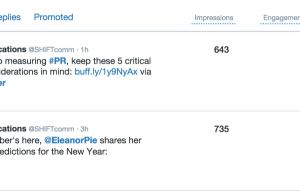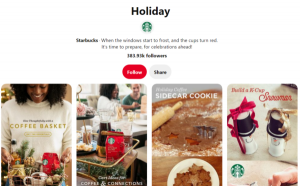Your guide to crushing it with video in 2022
These are unprecedented times – or so they keep telling us – but the effectiveness of video hasn’t faltered over recent times. As we move through uncharted territory, the stories you tell and how you tell them, through your social channels, will greatly affect how your business is perceived to be faring.
The visual image or more significantly, the moving image, will continue to be your main weapon in your communication strategy throughout this new year. How you choose to utilise and execute this tool will be decided by many factors….
At Three Motion we’re witnessing a shift in the way that businesses approach and apply video to their marketing mix. As the tools to shoot and edit videos become more widely accessible, we’re undoubtedly seeing more videos being created and shared. As a consumer of video, we become increasingly familiar with seeing content in our feeds, and consequently, the need to ‘breakthrough the clutter’ continues to rise.
1) Understand your audience
Social media is a hungry beast and one which needs feeding constantly. Take time to assess where you should be sharing content and then seek to understand how best to deploy on those platforms. If not careful, it’s easy to become overwhelmed with choice. There are so many places and platforms – but the reality is that it simply isn’t possible to be everywhere and anywhere. Choose which platforms you know you can master, have the capacity to manage and stand out upon.
In a 2021 State of Video Marketing report, 86% of businesses said they use video as a marketing tool. And 93% of respondents say it’s a critical part of their strategy.
2) Leverage your content
When approaching your shoot, whether in-house or shot professionally, ensure that you get as much bang for your buck as possible. Taking a ‘multi-platform’ approach (sharing across all your chosen social platforms and website) will ensure your campaign has the best chances of success. Explore how you can create as many clips as possible from the shoot; creating master content and additional cuts that can be harvested from the production. It’s much easier to create these if planned – opposed to it being an afterthought.
Research has found that 84% of consumers have been convinced to buy a product after watching a video, and they’re twice as likely to share videos than other types of online content. Cisco reported that by 2022, the video will account for 82% of all online traffic.
3) Know when to leave it to the professionals
Mobile phones are great – and the quality of their video capture has risen greatly – but understanding when to hand over to a professional team will guarantee you don’t risk missing the target. You will always be judged by the quality of your communication, so make sure you choose professionals when it matters. Choose an experienced video production company with a proven track record in creating content within your industry (or at least be able to demonstrate applicable approaches to achieve success). Do your research and check their portfolio and Google reviews or ask for recommendations. Request a meeting if you really want to explore the best approach and understand the various approaches that you could take.
94% of marketers said paid video ads had a positive ROI for their business.
4) What is your call to action?
It’s all too easy to forget to ask for action at the end of your video. We push content out into the ether and often fail to request engagement in any form. What is the purpose of the video? What objective is it linked to? What do you need audiences to do, following watching the video? This will both serve to engage the audience and help you ascertain and measure its success.
Online video is predicted to be the leading source of web content by 2022, with 82.5% of all web traffic.
5) Vertical videos
Vertical videos are here to stay – and if you’re sharing across the likes of Instagram and TikTok, you’ll be very familiar with the increase in popularity of this format. ‘Stories, reels and short-form bursts, allow brands and creators to offer not only raw insights and behind-the-scenes insights, but also an opportunity to share professionally crafted content, specifically created for these mobile-first channels.
It is estimated that the average person will spend 100 minutes every day watching online videos in 2022.
6) Stay ahead of the curve
Keeping ahead of the trends, learning new platforms and knowing when to take action is a full-time job. Learn from the experts in your industry and attempt to replicate success where you see it. Technologies such as augmented reality and VR are very much here to stay – but their application, in your line of business at least, maybe some time off. Keep one eye on the future and one eye on how you can make gains in the present. What are the trends in your industry? Perhaps you can take advantage of producing more short-form ‘reels’, offering webinars or producing a podcast. All of these are accessible – and with a little research, easy to master and deploy. Be selective and choose a strategy you’ll enjoy and be willing to stick with.
94% of video marketers say video has helped increase user understanding of their product or service.
7) To go short or go long…that is the question!
It’s true that our attention spans are becoming shorter, so lean into this trend by creating a plentiful supply of short videos that can be scheduled and deployed over time. Whilst it can be difficult to plan too far ahead, perhaps start by exploring a list of typical questions you could answer for your customers? What is your product USP? Once you have a list of topics, decide is something you can capture yourself or do you need professional help to bring these clips to life.
Conversely, keep in mind that if your audience is genuinely interested in your product or service, then they will be prepared to invest the time to find out more if indeed it helps them make a decision or help solve their problem. Your ‘long form’ content might sit on your website – and once a prospective customer has found you (perhaps through your social posts) – then this is the place they will come to find out more. Take the time here to educate your audience and answer their questions. A considered purchase may well justify more investment in time from your customer – so don’t short change them.
More than 55% of shoppers globally say they use online video while actually shopping in-store.
8) Play to your strengths
There will always be a time for user-generated content ‘UGC’ and professionally-crafted video. Knowing when to use each is critical. Ask yourself, do you have the skills to create content that you’re proud of? Will UGC support your marketing objectives and increase the likelihood of success. Whilst it’s true that there is a home for ‘raw-content’ – consider its purpose and what you hope it will achieve. Sharing video for the sake of it does little but waste time and effort. The analogy ‘no content is better than poor content’ is often true. If writing or live speaking is your strength, then lean into what you’re good at and seek professional advice/support for the other areas. Just because you can use a pair of scissors, doesn’t mean you should cut your own hair…
In 2020, it was noted that 54% of businesses with a landing page had videos for their ads.
9) Live Video
This one has appeared on our list for many years and the ability to easily share your live rambles and events makes this option very powerful and time-effective. Many businesses will lend themselves nicely to the ability to simply ‘hit record’ and share a live event – either as a teaser or demonstration of their service. If speaking to the camera is a strength – then again, this is a very cost-effective route to sharing your content. As always, plan in advance and consider a content calendar to keep you on track and organised.
Wyzowl says that 66% of consumers prefer watching a video to reading about a product.
10) Deploy a strategy
Perhaps the most important takeaway from this is the need to create a strategy. The start of the year is the perfect time to plan the year ahead and consider the following:
- What is the focus
- Who am I talking to
- Where will I find this audience
- What type of content will best suit them
- What does that look like
- What is the focus
Once you’ve answered these questions, you can then assess how best to achieve your goals, create a time and execute against it.
Final thoughts:
Video Production offers huge opportunities for those who deploy it effectively – but like any marketing asset, how your approach your video marketing strategy, should be explored in the company of a professional agency. That’s not to say that you’ll end up needing a glossy promo – but the right agency will help you consider the correct approach and if needs be, can provide training and support to help you create video internally – if that is the best route.
Business 2 Community(23)






